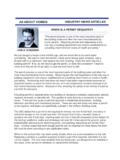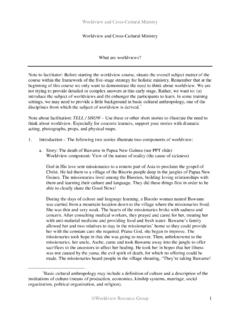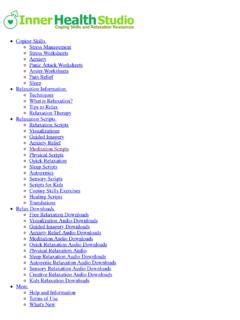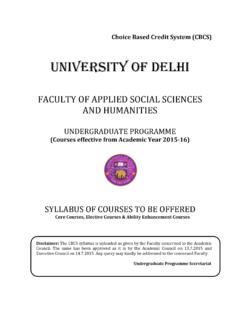Transcription of TOR Impact Assessment - OTELP
1 TERMS OF REFERENCE Impact Assessment of Programme Activities under Orissa Tribal Empowerment and Livelihoods Programme ( OTELP ) Background of OTELP The Scheduled Tribe and Schedule Caste Development Department, Government of Orissa, (ST & SC Dept) is implementing Orissa Tribal Empowerment and Livelihoods Programme ( OTELP ). This is supported by IFAD, DFID, WFP as external supporters and Government of Orissa as Counterpart funder. The programme started implementation in October 2004, and is operational in 30 blocks of 7 south west districts of Orissa. The objective of the programme is to ensure that the livelihoods and food security of the poor tribal households are sustainably improved through promoting a more efficient, equitable, self-managed and sustainable exploitation of natural resources available though off farm and non-farm enterprise development.
2 Implementation under OTELP Capacity Building and Institution Development The key programme objective of empowering tribal people is to be achieved by mobilising and organising them and building their capacities, building their local organisations. Village Development Committees, Village Level Sub-Committees, Village level Finance and Social Audit sub-committees and various user groups have been promoted at the village and watershed level. Several training programmes and exposures have been conducted to build the local capacities. To effectively aid in facilitation, FNGOs, RNGOs and ITDA play supportive roles. From the PSU, capacity building activities have been taken up for enhancing the capacities of the support agencies. Livelihoods Enhancement The programme Phase I is being implemented in the ten tribal concentrated blocks in four southern west districts of Orissa covering 396 villages spread over 136 micro watersheds.
3 The programme adopted the watershed management as a platform to implement the programme. The area and the beneficiary profile of the programme is given below: Programme Coverage Unit Koraput Parala khemundi Balliguda Th. Rampur Total No. of Micro Watersheds Number 30 40 30 36 136 No. of Villages Number 88 106 82 120 396 Treatable Area (in Ha.) Ha 15205 15000 Total Household Number 7019 4877 3308 3991 19195 ST Household Number 5983 4874 2031 2945 15833 SC Household Number 717 3 890 711 2321 BPL Household Number 5317 3749 1787 3437 14290 Source: Programme M&E, PSU, 2007 Under the programme, for livelihoods enhancement, various natural resource management activities like land and water management, agriculture and horticulture development, aquaculture, nursery raising and plantation have been taken up in the last three years in the first phase villages.
4 To aid in effective implementation and ownership, micro watershed approach was adopted, complementary people s organisations like the village development committees and users groups have been formed and strengthened. Training and capacity building activities have been very integral to the organisation development and livelihoods promotion activities. Each watershed committee has a band of volunteers to support the field implementation of the different components of the NRM activities. Further, the programme has entered into strategic partnerships with technical institutions like ICRISAT, CTCRI, RPRC for accessing up to date technical know-how. Out of the total investment, NRM activities use more than 50 per cent of the funds. The Mid-term Review (MTR I) Phase I has assessed the performance of these activities mostly as satisfactory and very satisfactory.
5 The Joint Review Missions have also rated the implementation of the NRM activities as satisfactory. Rural Financial Services The programme promotes formation and strengthening self-help groups (SHGs), gradation of the SHGs for bank linkage and business development. The programme has developed guidelines for strengthening the rural financial services. As on October 2008, there are 2195 SHGs in the programme area. Policy Initiatives The programme has engaged in facilitating settlement of land in favour of the tribal landless and marginal land holders. The land patta is being allotted in the joint ownership of wife and husband. Objective of the Consultancy The programme has entered into the second phase and exit plans will be developed for the Phase I villages. This is a critical point of reflection for the programme to take the learnings from the first phase implementation.
6 These lessons will be useful for both the phases. More importantly, it is important to understand the extent of the contribution of the investments towards empowerment, livelihoods and food security of the target population, and provides sustainable access and control over the social resources, natural resources and financial resources by the tribal communities. Thus Landless Household Number 2426 1160 735 1058 5379 Total Population Male Number 14825 15400 7045 9235 46505 Female Number 15157 15784 6853 9516 47310 ST Population Male Number 12663 15393 4578 6751 39385 Female Number 12927 15777 4507 6963 40174 SC Population Male Number 1190 7 1978 1601 4776 Female Number 1187 9 2083 1648 4927 the programme will undertake a concurrent evaluation of impacts the programme activities for empowerment and livelihoods enhancement.
7 Impacts here are understood to encompass both outcome and Impact levels tangible and intangible attained by the programme. Working closely with the Programme Director and the Programme Support Unit, the consultants will assist in the Impact Assessment of the programme activities implemented under OTELP . The proposed key objectives of the technical support are: 1. Determine direct and indirect outcomes and impacts and assess the effectiveness of complete range of OTELP s interventions and institutions on the resources, lives and livelihoods of its target communities especially the poor in the programme areas. 2. Undertake economic analysis like cost benefit analysis, rate of return on investment and economic sustainability of the NRM activities 3. Identify gaps, opportunities and lessons in the current implementation which can be incorporated into the second phase as well as in the first phase 4.
8 Analyse and comment on the long-term sustainability of the programme outcomes/impacts and suggest measures to achieve and maintain long-term sustainability 5. Develop a story line on the outcomes/impacts of the programme, focusing on the analysis of the poverty Impact covering: Utilisation: Analysis of specific use of funds and beneficiary patterns. Analysis of how the OTELP funds serve to secure lives of households and communities on a sustainable basis. Services: Analysis of the extent to which OTELP enhances access to improved basic services to all citizens including the poor and marginalised. Social Protection Programmes: The level of access to key Centrally Sponsored Schemes (specifically NREGA and Social Insurance programmes) by poor and marginalised women and households.
9 Targeting: Analysis of the extent to which OTELP funds along with other untied resources targeted at the poor and vulnerable. Coverage: Analysis of the coverage in terms of households who have received benefits from OTELP . This information will need to be disaggregated by gender, social groups and income quintiles. Incomes: Analysis of the annual changes in income of poor households specifically the poorest 10% of households. Food security: Analysis of the extent to which food security is an issue at the household level specifically across the poorest 10% of the population. Assets: Analysis of asset creation. Scope of work The Assessment should examine of the effects of the programme interventions and include both planned and unplanned impacts and those that are directly and indirectly a consequence of the results.
10 In doing so, the Assessment should try, wherever feasible, to differentiate the changes that are attributable to the programme interventions from other external factors contributing to change. This study should assess the Impact of the programme on the land use, cropping pattern, productivity and production, water availability and irrigation in the programme areas; on employment and income of the households; Impact of and on institutions; access and empowerment especially of marginalised people. The study should attempt to distinguish between short-term and long-term impacts: which changes are immediate, which occur only over time, which is hoped for but not yet evident? Which changes are temporary and which permanent? It should assess differences between stakeholders: who is affected, in what ways, and why?








